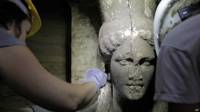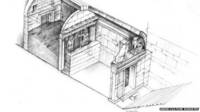- November 12, 2014
Post

In lush times the tomb of Alexander the Great, found in northern Greece, archaeologists found the skeleton.
Burial at Amphipolis – the largest ever found in Greece.
The Ministry of Culture of Greece stated that the well-preserved remains of the skeleton is a representative of the highest nobility. This is evidenced by the dimensions of the tomb and the splendor of its decoration.
Chief Archaeologist Katerina Greece Peristeri said buried – man, probably a military leader.
Excavations at Amphipolis engage the attention of the public from August when visiting their Prime Minister Antonis Samaras announced exceptionally important discovery by archaeologists.

Recent reports of artifacts found in the tomb, only stoked interest Greeks, Gad, whose burial found in Amphipolis.
“This is a very expensive design, no private citizen could not afford it – said the Ministry of Culture at a press briefing held on Wednesday. – In all likelihood, this burial mortals who worshiped his contemporaries “.
Different assumptions and guesses, a host. Experts do not exclude that it is a member of the family of Alexander the Great or one of his confidants.
Burial dates from the late 4th century BC, when Amphipolis was an important center of the Macedonian kingdom.
The place of excavation is 100 km east of Thessaloniki, the second largest city of Greece.
New finding
Before the skeleton was found, expressed speculation that it may be a cenotaph – a symbolic tomb without a corpse. These tombs were built in honor of notable people buried elsewhere.
The tomb with a skeleton was found at a depth of 1.6 m below the floor of the third chamber of the funeral complex. Its dimensions – 3.23 m long, 1.56 m wide and 1.8 m in height.
Inside was a wooden coffin. Archaeologists have found the bronze and iron nails, as well as fragments of bone and glass. Apparently, they were used in the decoration of the tomb.
The skeleton and found genetic material will be examined by experts, the minister of culture.
In the earlier stages of the excavations there were found magnificent lions, carved from stone, two sphinxes, two caryatids and a mosaic floor with an illustration of the myth of Persephone’s abduction.


Amphipolis
- Founded in the year 437 BC .e. near the gold and silver mines Pangaea
- In 357 BC. e. conquered by the father of Alexander the Great King of Macedonia, Philip II.
- When Alexander served as a naval base from which fleets were sent to the coast of Asia
- In 1964 began the first excavations here
No comments:
Post a Comment